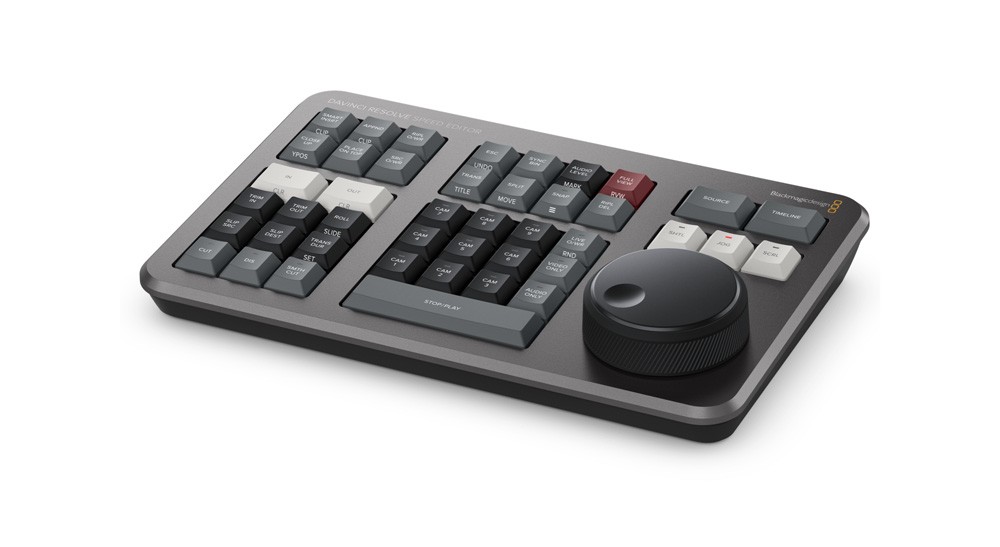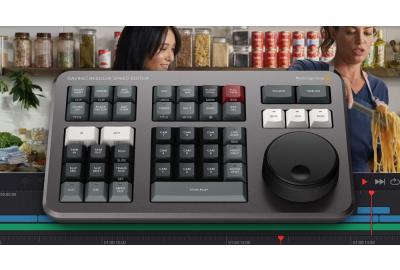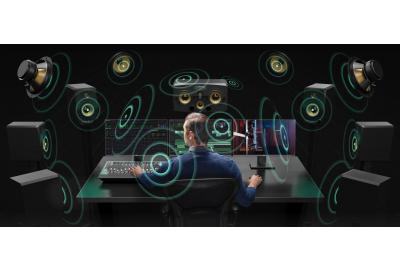DaVinci Resolve Speed Editor Features
- Source tape allows faster clip searching.
- Large trim in and out buttons.
- New keyboard modes for intelligent editing.
- Buttons to allow search dial to live trim.
- Buttons to change transition type.
- Integrated search dial control.
- Keypad for direct timecode entry.
Fremont, California, USA - Monday, November 9th, 2020 - DaVinci Resolve Speed Editor, a new keyboard for DaVinci Resolve's cut page that allows for a new and dramatically faster editing solution that is a combination of integrated hardware and software, was announced today by Blackmagic Design. Because, unlike a mouse, the DaVinci Resolve Speed Editor has control over each edit function and can perform multiple tasks at once, the editor can work much faster. Furthermore, for a limited time, any customer who purchases DaVinci Resolve Studio from a Blackmagic Design reseller will receive the DaVinci Resolve Speed Editor for free!
DaVinci Resolve Speed Editor is available immediately from Blackmagic Design resellers worldwide for US$295.
Customers must constantly click and drag clips to edit in traditional edit software, which uses thousands of clips to organize their media. That's too slow for work like TV commercials, news, promos, and training videos. However, with old tape-based linear editing, all media was played from a videotape, so customers could simply fast forward and rewind to see all of their shots. The "source tape" is a modern version of the videotape that is now available on the cut page. Simply press the source button and use the search dial to browse all of their media. In addition, the current clip in the bin is highlighted in real-time. Following the edit, the viewer will remain in the source tape, allowing customers to move faster to the next shot.
Because entering in and out points is the most commonly used editing function, the speed editor keyboard includes large in and out point buttons that customers can easily locate by feel. That's ideal for two-handed editing, in which users use their right hand to control transport while their left hand places in and out points and performs edits. Customers can simply move the search dial along with them and place in and out points wherever they want. Once the in and out points are set, they can perform the edit by reaching their fingers up to the edit function buttons. The in and out points can be used to focus the source tape as well. Customers can then change the source tape back to the entire bin by pressing the escape key.
Because editing with a keyboard differs from editing with a mouse, the cut page editing functions have been improved to take advantage of the speed of a keyboard. The edit functions are intelligent and use the "smart indicator" in the timeline to determine where to insert, so most of the time customers do not need to place in or out points in the timeline to do an edit. They are located just above the in and out keys and are easy to find by feel. Furthermore, each time a customer edits, the cut page will not waste time switching over to the timeline, allowing customers to stay in the source tape and visually browse, placing clips continuously. That's much faster because customers can just keep throwing clips in.

Customers get an extremely accurate way to trim shots with a large high-quality search dial built into the panel. Because the search dial is such a large physical control, it completely changes how it feels to trim shots. It's also much faster. Customers simply hold the trim buttons and rotate the search dial to convert the search dial into a trim control. Customers can thus select different trim modes with their left hand while adjusting the trim with their right. It's extremely fast, and a smart indicator in the timeline informs customers about which edits are being trimmed. Simply move your cursor along the timeline to see live trim edits. It's a completely different way of working.
Because customers must click and drag effects down into the timeline, editing software can be slow when adding transitions to edits. Customers can, however, turn them on and off with the DaVinci Resolve Speed Editor by simply pressing a button. Customers can scroll down the timeline and add or remove effects, making it extremely fast. The smart indicator in the timeline will inform customers which edit point will be affected, and customers can move the timeline to change the focus of the edit point. The cut key will remove any effect on a timeline edit point. When you press dissolve, you'll add a dissolve to the edit point with the default duration. By pressing the smooth cut button, you can add a smooth cut to your design.
The DaVinci Resolve Speed Editor does away with the large QWERTY keyboard in favor of a smaller, more portable design, so the function button area contains only the editing controls that customers require. Some of the DaVinci Resolve Speed Editor's enhanced function keys are not even available on the full-sized editor keyboard. Furthermore, some keys have a secondary function that customers can access by pressing and holding or double pressing the same key. Customers will need fewer keys for a more portable design, but they will still have a lot of editing power. The keys are separated into groups so that customers can find the key they need by feel and operate faster than a standard keyboard.
The escape key is positioned to the top left so it's easy to locate, as it’s the most common key for reversing some functions. A good example is the sync bin and if customers select a camera, customers can go back to the multiview by selecting this escape key. Plus, if customers double press it, it works as undo.
The sync bin is a new style of multi-cam and it allows customers to find shots that are sync'd to the current shot in the timeline. That lets customers find cutaways using a familiar multiview interface. Then use the camera keys to select an alternative shot, and source overwrite to edit it into the timeline.
The audio level key lets customers quickly set audio levels of clips by holding the key and adjusting the level using the search dial. That's a fast way to set audio levels while editing. Double pressing the key lets customers add a marker, and double pressing and holding allows customers to set the marker color.
The full screen button is highlighted red so customers can find it quickly and switch to a full screen view of their viewer. That’s great for presenting their edit to clients. Plus if customers double press the full view button, it will go into full screen view and play from just before their most recent edit.

The transition button is similar to the cut and smooth cut buttons, however it will add a custom transition of their choice from a pallet of all the available DaVinci Resolve transitions. If customers press and hold the transition button users will see the pallet appear allowing selection of the one customers want.
The split button will instantly cut the clip in the timeline at the current playback point. If users are positioned on a split in a clip, then pressing the split button will remove the split. If customers press and hold, customers can use the search dial to move the current clip up and down the timeline.
Pressing snap will turn on snapping in the timeline. Snapping on the speed editor is different, as it’s not magnetic so it’s more subtle. It works by momentarily pausing jog at the edit points so it's nicer to use. Or if customers press and hold, the search dial will let customers adjust the viewer size.
Ripple delete removes the current clip at the playback point then ripples the timeline to fill the space left by the deleted clip. This eliminates any blank spaces in the timeline. Customers can use it with split to remove parts of shots customers don't want. Plus, it will also reduce their timeline duration.
The camera number section lets customers select the cameras when using the cut page sync bin. Plus, if customers press a camera number while turning the search dial, the selected camera will be applied to the timeline in real time as customers jog forward. This feature is called live override and on the speed editor panel customers can do it momentarily by holding the camera button, or customers can latch it on using the live override button. When live override is latched on, the buttons light up and customers can select cameras just like a production switcher. Customers will see a multiview and customers can just cut from camera to camera. Plus, this section even has the video only and audio only buttons for greater editing control.
The DaVinci Resolve Speed Editor model includes built in Bluetooth so customers can use the keyboard without messy wires, and customers can even use it in conjunction with their regular computer keyboard. That’s perfect for using it with a laptop. Customers can also use the keyboard via USB if required and the USB connection will also charge the internal battery. With Bluetooth and a built in battery, the keyboard is extremely portable.
"We think this is an incredibly exciting product as it has such dramatic workflow ramifications," said Grant Petty, Blackmagic Design CEO. "Until now, editing software has been designed to be used with a mouse, however that’s slow as each edit function often takes multiple mouse clicks to do each task. Now with the DaVinci Resolve cut page and the DaVinci Resolve Speed Editor being co-designed, it means they work together for a whole new generation of editing workflow. It's so fast and a lot of fun to use!"






